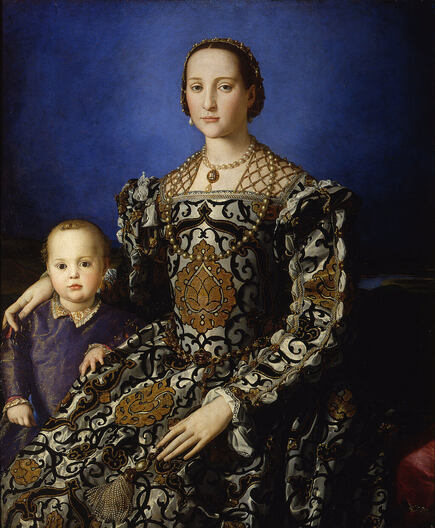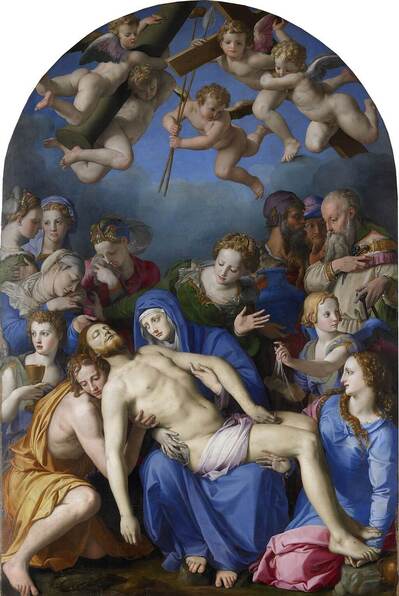|
Where? The Private Chamber of Eleanor in the Palazzo Vecchio
When? 1541-1542 Commissioned by? Cosimo I de’ Medici and/or his wife Eleanor of Toledo. What do you see? This fresco shows three different scenes related to the biblical story of the Jews that escaped from Egypt where they were repressed. First, the three young people in the center foreground and the three people in the left foreground represent the Jews that were preparing to escape from Egypt (note that the bottom left of the painting is missing due to damage from moisture). For example, the man on the left has some unleavened bread on his head which the Jews took with them when escaping Egypt. You can also see a silver jug and a gold basin from the Egyptians in the foreground. Second, the fresco shows the escape from the Jews from Egypt by crossing the Red Sea. In the top right you can see the Jews who safely crossed the Red Sea after God opened it up for them. If you look carefully, you can see that one of the Jews on top who still has the unleavened bread on his head. The man among the Jews in the blue robe is Moses. In the sea on the left, you can see the Egyptians and their horses getting drowned while they were chasing the Jews.
Backstory: In 1539, Cosimo I, Duke of Florence, married to Eleanor of Toledo and in 1540 they moved into the Palazzo Vecchio. At that moment the Palazzo Vecchio was not decorated like a palace that could impress its guests, so Cosimo I commissioned several artists to decorate the palace. This fresco was painted for the private room (also referred to as the chapel) of Eleanor of Toledo, which was one of the first rooms in the Palazzo Vecchio to be decorated.
The story in the painting contains both the beginning and the end of the story of Moses in the Bible. In the beginning, he leads the Jews through the Red Sea to get out of Egypt where they were repressed (see Exodus 14). After that, the Jews wandered for 40 years through the desert before they could see their promised land. Before entering the Promised Land, Moses passed on his leadership to Joshua (see Numbers 27), and Moses died with the Promised Land in sight. Symbolism: This painting contains various allusions to Cosimo I and his wife, Eleanor. Moses alludes to Cosimo I, who wants to be perceived as a new Moses; someone who leads his people to new heights. The crossing of the Red Sea by the Jews alludes to the 1537 battle of Cosimo I at Montemurlo, in which he ended all opposition to the Medici family as rulers of Florence. The appointment of Joshua by Moses refers to the birth in 1541 of Francesco, the son of Cosimo I and Eleanor, who had to succeed Cosimo I. Who is Eleanor of Toledo? She was the Duchess of Florence from 1539 till 1562. Eleanor of Toledo (1522-1562) was born in Alba de Tormes in Spain and was the first wife of Cosimo I, who was the second Duke of Florence and became the first Grand Duke of Tuscany in 1569. The marriage between the two was a political marriage as it strengthened the position of the Medici family. She got 11 children with Cosimo I and they had a faithful and good marriage. Bronzino painted a well-known portrait of Eleanor and one of her sons which is on display in the Uffizi Museum in Florence.
The Private Chamber of Eleanor: This room was used by Eleanor to escape the hustle and bustle of everyday life and to pray to God. It contains several frescos.
Who is Bronzino? Agnolo di Cosimo (1503-1572) was born near Florence and is better known as Bronzino. He is one of the most important painters in the Mannerist movement in the 16th century. He was a big fan of the works of Raphael and Michelangelo. He was an excellent portrait painter but also painted many biblical scenes. He was the court painter of the Medici Family when Cosimo I was in charge of Florence.
Despite his talents, he is somewhat less popular than some of the other famous painters of his time. The main reason is that the paintings of Bronzino lack drama and dynamism. The figures that he paints often lack emotions and are depicted in a calm state. For example, look at the lack of drama in the very calm sea in which the Egyptians are drowning in this painting. Fun fact: Bronzino included several (almost) naked people among the Jews, including the figure in the right foreground. The ancient Greek statues inspired the shapes of these nudes. The person in blue to the left of Moses in the foreground is a self-portrait of Bronzino. The lady on the right with her hand on her belly is probably Eleanor who was pregnant. She was pregnant with Francesco, who would succeed Cosimo I and ensure the continuation of the Medici family as rulers of Florence. Francesco was born on March 25, 1541, which was the day on which the founding of Florence was celebrated. The timing of his birth was not considered a coincidence and exploited by the Medicis as a sign that Francesco was destined to be the new leader of Florence.
Written by Eelco Kappe
References:
0 Comments
Leave a Reply. |
Categories
All
|
- Home
- Blog
-
Museums
- Alte Pinakothek
- Art Institute of Chicago
- Baltimore Museum of Art
- Barber Institute of Fine Arts
- Bargello
- Barnes Foundation
- British Museum
- Church of Sant’Anastasia
- Cleveland Museum of Art
- Courtauld Institute of Art
- Detroit Institute of Arts
- Frans Hals Museum
- Galleria Borghese
- Gallerie dell'Accademia
- Getty Museum
- Guggenheim
- Hermitage Museum
- Kunsthistorisches Museum
- Kunstmuseum Basel
- Legion of Honor Museum
- Louvre
- Mauritshuis
- Metropolitan Museum of Art
- Musee d’Orsay
- Museum of Fine Arts in Boston
- Museum of Modern Art
- National Gallery in London
- National Gallery of Art
- National Museum in Poznań
- Norton Simon Museum
- Ny Carlsberg Glyptotek
- Palace of Versailles
- Palazzo Pitti
- Palazzo Vecchio
- Petit Palais
- Philadelphia Museum of Art
- Prado
- Pushkin Museum
- Ravenna Art Museum
- Rijksmuseum
- San Diego Museum of Art
- Santa Maria delle Grazie
- St. Peter's Basilica
- Städel Museum
- Statens Museum for Kunst
- Tate Britain
- Tate Modern
- Timken Museum of Art
- Uffizi
- Vatican Museums
- Wallace Collection
-
Artists
- Altdorfer
- Anguissola
- Berlin Painter
- Bosch
- Botticelli
- Boucher
- Bronzino
- Bruegel the Elder
- Brunelleschi
- Cabanel
- Caillebotte
- Canova
- Caravaggio
- Carpeaux
- Cezanne
- Cimabue
- David
- Degas
- Delacroix
- De Maria
- Donatello
- El Greco
- Fontana
- Fra Angelico
- Fragonard
- Gauguin
- Gentileschi
- Gericault
- Gonzalez-Torres
- Goya
- Hals
- Hogarth
- Hokusai
- Ingres
- Leonardo da Vinci
- Lippi, Filippo
- Longhi, Barbara
- Lorrain
- Makovsky
- Manet
- Massys
- Matisse
- Merian
- Michelangelo
- Mochi
- Modigliani
- Monet
- Panini
- Parmigianino
- Perugino
- Picasso
- Pisanello
- Raphael
- Rembrandt
- Renoir
- Reynolds
- Rivera
- Rodin
- Rubens
- Scultori
- Seurat
- Steen
- Tintoretto
- Titian
- Toulouse-Lautrec
- Turner
- Uccello
- Van der Weyden
- Van Dyck
- Van Eyck
- Van Gogh
- Van Hemessen
- Vasari
- Velazquez
- Vermeer
- Veronese
- Vigée Le Brun
-
Locations
- Books
- About Us




